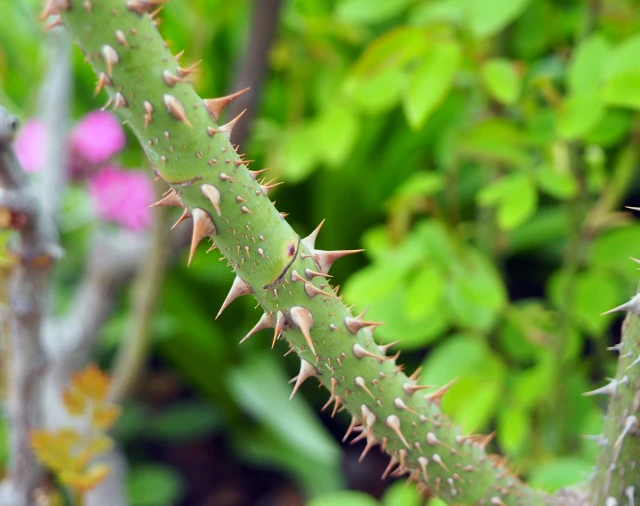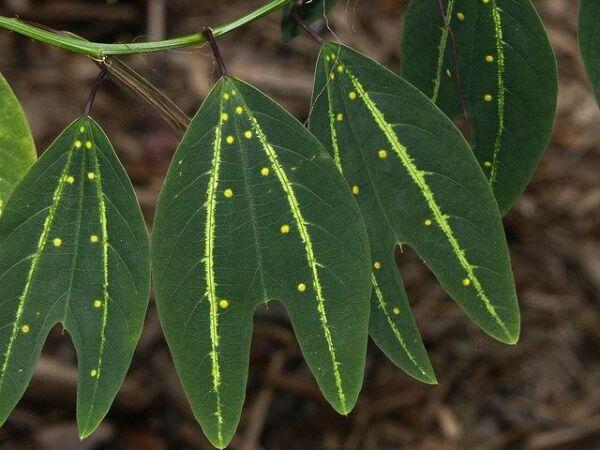How plants defend themselves? If there is a way plants can't defend themselves, that's running away. Plants, indeed, they are immobile (although not that much). But then how do they defend themselves from the attack of various parasites, like microorganisms, virus, mushrooms, insects, hungry predators and competition from other plants? Not only, they must also be able to protect themselves from various physical factors and critical conditions, such as a shortage or excess of water, or from excessive sun exposure. Plants have various physical barriers at their disposal, which together with the production of toxic metabolites constitute defense mechanisms and act as a deterrent so that parasites and herbivores do not attempt to damage the plant.
Whether it's about stress biotici, like herbivorous insects, virus, battery, mushrooms, or stress abiotici, including temperature, water shortage or excess water, plants, not being able to escape the stress, they must necessarily adapt to the conditions in which they find themselves. Over time they have been able to develop effective defense strategies. For example, when the plant recognizes a foreign organism, the expression of numerous genes is induced in order to activate different mechanisms for the production of enzymes or other molecules.
In time, between plants and other organisms within an ecosystem, refined interactions have been created that influence organisms at all levels, from biochemical to genetic aspects. Some of these relationships are mutually beneficial, like pollination, but most interactions involve predation. Furthermore, plants can also communicate with each other, thanks to the action of chemical compounds that inhibit the growth of nearby plant organisms, with a mechanism called allelopathy.
Defense strategies
The plants have some constitutive defenses, or innate, and of induced defenses, given by the production of bioactive compounds in response to damaged tissues, for example by some insect. Herbivorous insects, indeed, they can induce the release of various internal signals due to the injured tissues, come flows of calcium ions, phosphorylation cascades, a form of communication that involves a chemical reaction that consists of the addition of a phosphate group to another molecule and the release of jasmonate, specific lipid-based plant hormones. These different substances and messages are perceived by undamaged tissues, which subsequently strengthen their defense by producing different defense compounds. These are specialized bioactive compounds that can repel or intoxicate insects, while other defense proteins can interfere with their digestion.
As soon as a herbivorous insect begins to feed on a plant, different signals are therefore induced, leading to different defense responses. Plants have the ability to distinguish between damage caused by herbivorous organisms and mechanical damage, like hail and wind; Furthermore, they are able to recognize the laying of eggs, because these release particular fluids on the surface on which they are placed.
Plants are also able to recognize compounds present within the oral secretions of insects. These compounds induce the production of volatile substances in greater quantities than mechanical damage alone. But the secretions of some animals contain particular enzymes capable of blocking the plant's defense response, like some secrets of Helicoverpa zea (corn verme) and proteins identified in the salivary glands of Myzus persicae (green peach aphid).
Some plants distribute poisons throughout their system, others confine them to particular organs. For example, the leaves are often toxic. On the contrary, the fruits are free of toxins, indeed they have colours, perfumes and sugary substances very inviting for animals. While the seed can be protected by a hard rind and an abundant dose of toxic and potentially lethal substances.
Mechanical defenses
Mechanical barriers represent a first line of defense, without energy consumption, and this is why they are defined passive defenses.
Plants use these barriers to protect themselves, represented by morphological characteristics such as the cuticle, ask for it, which thicken and cover the surfaces of the plant; of the trichomes, a kind of hairs located on leaves and other organs that flies and fungi are unable to penetrate; or latex-like substances, which make feeding insects more difficult.
There may be particular stinging hairs positioned in strategic points, as in nettle, in chili pepper and elderberry. These are glandular hairs capable of injecting stinging substances such as stinging substances into the predator's tissues formic acid, acetylcholine and histamine.
In some cases, plants are able to modify these barriers following the attack of predators, by increasing the thickening of the epidermis cell wall or by the production of gums inside woody vessels, to hinder the spread of the pathogen.
Chemical defenses
Instead, chemical defenses are defined active or inducible defenses. This defense entails a metabolic cost and the compounds could also be toxic to the plant itself.
These are chemical compounds, in some cases with antimicrobial activity, which can be found as such within the plant or in the form of precursors, that once they come into contact with the pathogen, are converted into a biologically active form, inside the plant cells. Examples are saponins and polyphenols.
Some have an unpleasant taste or odor, with an effect repellent on the animals that eat them. There are others irritating or toxic at high concentrations, but some may be lethal for large animals, even in small doses and potentially even for humans.
There are also volatile organic compounds released following attack by pathogenic microbes; like terpenes, compounds containing nitrogen, fatty acid derivatives, and volatile plant hormones, such as methyl jasmonate and methyl salicylate. Some volatile substances are released to repel herbivores; attract pollinators and for communication between leaves of the same plants or for communication with other plants. All these substances have the purpose of inhibiting the growth of fungi and/or bacteria, which can occur with digestion of the fungal wall or lysis of the bacterial wall.
Examples
- Nettle defends itself mechanically and chemically: its leaves are covered with small thorns and the latter also contain a substance that irritates the skin.
- In Gentian the presence of’gentisic acid, together with’salicylic acid, it is considered a defense response to attacks by pathogens.
- The Hemlock (Conium maculatum), of which the philosopher Plato says that an infusion killed his teacher Socrates, is a herbaceous plant belonging to the family Apiaceae which can easily be exchanged with parsley, but on the contrary it has a very unpleasant odor. Odor which is due to the presence of several toxic alkaloids, including: the coniine, chonydrin, pseudochonydrin, methylconicin and conicein, all belonging to a class of neurotossine responsible for the high poisonousness of the plant.
- The oleander (Nerium oleander) it is an evergreen shrub belonging to the family Apocinaceae, typical of the Mediterranean. The whole plant contains cardiac glycosides capable of altering the heart rhythm, causing arrhythmias. The toxic active ingredient is called oleandrina and interferes with the normal activity of heart muscle cells and is capable of causing serious heart problems.
- The latex that comes out of poppy seeds (Papaver somniferum) it is rich in dozens of different alkaloids, which belong to the opiate group. Between these, the main ones are morphine and codeine, both toxic.
- Apricot kernels contain a relatively large amount of amygdalin, a cyanogenic glycoside which releases hydrogen cyanide during its digestion (cyanide), highly toxic. This substance is also present in apple seeds and cherry stones, which are toxic if ingested in large quantities.
- Even the saponins they have a protective role against various microorganisms, insects and birds, who stay away from the vegetables that contain them due to their bitter and disgusting taste. They too can have a toxic effect on humans if taken in high quantities. Among the most common plants that contain saponins are licorice which contains glycyrrhizin, l’escina with an ever-growing interest on the part of citizens to know nature’horse chestnut. They are also contained in basil and oats, and it is precisely the saponins that make it resistant to mold and fungi.
- The solanine, instead, it is a secondary metabolite of an alkaloid nature contained in potatoes, in aubergines, in peppers and tomatoes, also useful for the plant's defense against fungi and insects.
Other secondary metabolites classified based on their chemical structure are phenols, flavonoids, stilbene, lignans from curcuminoids, they have a defense role against parasites of all types and protection from ultraviolet radiation; in some cases, they also impart pigment to various portions of the plant. The polyphenols among other things, they are powerful antioxidants, capable of neutralizing oxygen and nitrogen free radicals, they help plants defend themselves from external aggressive agents (UV rays, insects, fungi and diseases).
A particular willow, Salix sitchensis, it is able to modify the production of substances present inside its leaves when it is attacked by some defoliator larvae. Leaves, in this way, they become unpleasant to parasites because the willow stops producing attractive substances for insects in order to ward them off, while it releases other substances, managing to communicate the unwelcome presence of these insects to the surrounding plants, transmitting the message to nearby trees.
Mimicry
Even the phenomenon of mimicry can provide protection against herbivores. Thanks to this ability, a plant organism can change its appearance, physically or chemically, to resemble another organism. As well as encouraging pollination by various insects that are attracted to the modifications, the plant exploits this mechanism to not appear attractive to some insects or to simulate the appearance of a harmful species. This is the case of Passiflora, whose leaf blades bear punctate swellings on the surface: these are glands resembling butterfly eggs. This could be useful to prevent butterflies from laying their eggs on these leaves. Not only, in the lower lamina the same leaf glands emit a nectar which the ants are fond of, they travel along the stems and leaves of the plant, They keep parasites away.
Allelopathy
Another particular aspect of plant behavior is theallelopathy. That, indeed, they communicate with neighboring ones and compete with each other, for resources such as light, water and nutrients. They influence the growth of other plants through the production of various secondary metabolites, including: claviceps purpurea, glycosteroidi, terpenoids, PHENOL, flavonoids and saponins, which are accumulated in many plant organs (leaves, stems, rhizome, pollen) and issued through different methods: release into the atmosphere, with the rain, through the root system or through decomposition. All these factors and mechanisms can vary depending on the season and growth periods of the plant. In addition, allelopathy also plays an important role in defense against other predators.
It is true that plants are immobile, but they know how to defend themselves!
Sources:
- · https://www.ncbi.nlm.nih.gov/pmc/articles/PMC3676838/
- · https://www.ncbi.nlm.nih.gov/pmc/articles/PMC3676838/
- · https://digimparoreda.capitello.it/app/books/CPAC12_8361360A/html/227
- Poisonous and wild plants
- https://www.rivistadiagraria.org/articoli/anno-2019/lallelopatia-le-piante-influenzano-la-crescita-piante/
- A botanical collection from Crema: the Passion Flowers by Maurizio Vecchia
Image credits:
https://awkwardbotany.com/2022/05/11/randomly-selected-botanical-terms-prickles/
https://pixabay.com/it/photos/bruco-la-farfalla-a-coda-di-rondine-7434958/
https://www.faidateingiardino.com/erbe-e-piante-velenose/cicuta
https://www.facebook.com/biologicaIT/photos/a.468871016952283/898509037321810/?type=3











Leave A Comment